This article was originally published at Libertarianism.org on 11/17/2023.
In 1981, 88 percent of the Chinese population lived in extreme poverty. Today, this figure is less than one percent. In a country composed of nearly 1.5 billion people, that means hundreds of millions of people became more prosperous than ever over about four decades—hardly any time at all compared to China’s 3,500-year history.
Classical liberals and libertarians have observed throughout history that cities are disproportionately the centers of technological and economic development. However, for every rule, there is an exception. The rural village of Xiaogang in China, though small, is that exception: one that transformed not only China’s economy but, inadvertently, the whole globe’s.
The Great Leap Forward and Mass Starvation
A devout advocate of communism, Mao Zedong implemented a state-run economy. Bureaucrats decided what workers produced, who to hire or lay off, how much to invest, and what workers were paid. State-owned enterprises, where the only “enterprise” to be found was in the name, were dead weight on the economy and chronically underperformed.
Some opposed the Soviet-style model of economic planning being implemented in China, such as Gu Zhun and Sun Yefang. In 1956, Gu argued for the importance of the market even in a socialist economy. For his writings, he was denounced as a “rightist” and spent most of his remaining life behind bars or in re-education centers. Sun observed that state-owned enterprises lacked autonomy, they could not adapt to local circumstances. For his ideas, Sun was labeled a “revisionist” and was imprisoned for seven years during the Cultural Revolution.
Though behind bars, the observations of Gu and Sun proved prophetic after the disastrous policies of Mao’s infamous Great Leap Forward.
The Great Leap Forward was a large-scale social and economic campaign initiated by the Chinese Communist Party in 1958 to rapidly transform China from an agrarian to a socialist society through industrialization and subsequent collectivization. The chronic underfunding of agriculture and the glaring inefficiency of collectivization led to critical declines in food production. Historians estimate tens of millions died from starvation through mismanagement by the state during this period.
After the death of Mao Zedong in 1976, fervor for a state-run, collectivized economy fizzled. By December of 1978, the Third Plenary Session of the 11th Central Committee of the Communist Party of China (CPC) was held in Beijing, an event recognized as the beginning of China’s economic reforms and the opening up of its economy. The ensuing market liberalization propelled China from a stagnant socialist society to a dynamic economic powerhouse that has since shocked the globe.
But before politicians in Beijing relaxed their grip on the economy, large parts of rural China had been ignoring state policy for years. Xiaogang’s villagers drafted the blueprints for China’s meteoric rise.
Xiaogang Goes Rogue
The Great Leap Forward and misguided collectivist policies had the worst impact on provinces like Anhui. In the winter of 1978, in the province of Anhui, the impoverished villagers of Xiaogang gathered together for a group meeting about their future survival. Recent harvests under collectivization were yielding worse and worse results. The villagers decided that rather than farming as a collective, each family would tend to their own plot of land, keeping the fruits of their labor.
Eighteen heads of households signed a document that formalized some simple rules. Each signatory took an oath of silence and pledged to look after one another’s children if anyone was killed or arrested for breaking collectivist policy. The document was hidden inside a piece of bamboo on the roof of a farmhouse.
With villagers now autonomous, and responsible for their individual profits and losses, Xiaogang quickly became successful, producing a greatly increased crop only a year after the secret agreement was made. Understanding the plight of farmers, local state officials stayed quiet and allowed Xiaogang to continue. Though kept a secret, the example of Xiaogang spread, and other villages encountered similar successes. The peripheries of China were experimenting with the cornerstone of the future market economy: private property.
While the state stalled, real change occurred where state control was weakest. On the margins of China, a series of quiet revolutions paved the way for markets to flourish. Before politicians in Beijing relaxed bans on private farming, farmers had already adopted the practice throughout rural China, especially Anhui. Private property proved to be an economic tonic worth every drop. State officials began to notice marked improvements from what were formerly the poorest areas. The Chinese government softened its policy, admitting that markets and private property would be necessary to a prosperous, modernized China.
China’s Future
The Third Plenary Session which reformed the Chinese economy is now recognized as a pivotal turning point in China’s economic miracle. It was influenced by the example of a small group of farmers. Over the following three decades, the world’s most populous country transformed from a poor, stagnant, socialist economy into an economic powerhouse. Villages like Xiaogang rediscovered the benefits of private property. Farmers could make their own decisions and for the first time in decades their potential was unleashed.
The turn to private property and individual responsibility in the midst of Mao’s disastrous experiments in collectivism was not inconsistent with aspects of Chinese tradition. In the Tao Te Ching, the 5th century BC philosopher Laozi argued the state should rarely interfere with people’s lives, writing, “Governing a large country is like frying a small fish. You spoil it with too much poking.” Mencius, a student of Confucius, believed in free trade, and when describing a well-run state to King Hsüan of Qi, he explained that good kings kept taxes low, promoted trade, and raised no tariffs or levies on goods. The 17th-century scholar Huang Xongxi advocated for a constitutional system with a separation of powers and strong protections on private property. The Chinese people are by no means innately collectivist.
Xiaogang is evidence that prosperity does not come from state action, but rather arises out of the humble efforts of everyday people to make the world a better place. World history is shaped by great political leaders and powers but Xiaogang also shows us how unlikely people can find themselves at the head of a quiet revolution.
Though private property is no longer illegal, China is nowhere near being a liberal society. China tragically remains an authoritarian country. But when a country of over a billion people leans towards the market, the entire globe feels its weight shift. China did not become a laissez faire society overnight, powerful barriers to liberty remain. The Third Plenary Session did not plan for a “Great Leap” to capitalism, only a small step—but there is no step towards liberty too small to be celebrated and applauded.








